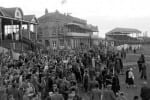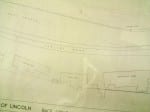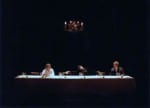Research and Ideas
The Tank is a key aspect to Lincoln’s History. Made and built in Lincoln by Foster & co. This revolutionary invention was to change the face of war for ever. Named the ‘Little Willy’, its creator William Tritton owner of Foster & co, developed and tested his creation on the west common opposite the grandstand. As a group we took a trip to the Lincolnshire life museum, in which a life size model of the Tank was displayed. Looking at the tank and its dimensions really made me realise how big the tank actually was. This sparked our creative ideas into us defiantly creating a tank for performance. We did not know at first how the tank was going too reflected in performance. It could become an instillation piece, a piece in which the audience could get involved or a tank memorial? Another idea was that we could recreate a scene that took place in the Yarborough suite, in the White Hart Hotel, Lincoln. In 1915 Tritton and Wilson used this room to develop the tank and it was suggested using filming we could recreate project it on to a wall in the grandstand then in front of their eyes have us working and building a model tank. As a group we wanted to in-cooperate all of our research and ideas into one so from there we thought of building a tank using materials that could be found on sight, and create a structure in which the audience could experience what it was like be inside the tank, and to observe it from the outside.
T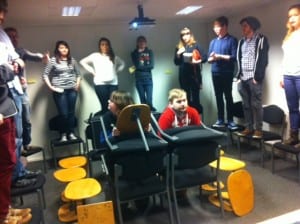 esting the Tank
esting the Tank
Our first attempt of recreating the tank was in a small room in the University’s Village Hall. Built from tables and chairs, the structure was almost tank like. It was somewhat an abstract look, taken from pictures, paintings and the tank we visited in the museum. Visible and one of the most important components to the tank were the caterpillar tracks. These observations lead to a significant development during our second attempt.
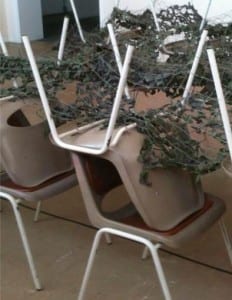
Our visit to the site was different this time, because we had an idea to play with. But nowhere to put it, we had the idea of creating the tank outside in the paddock, but then as we went through the curtain in the weighing room it felt like it should be built there. Looking so bare, the room could be shaped into anything we wanted. It was a blank canvas ready for us to take over and make our own. The weighing room can be seen as a ‘space that is unfixed’ but is ‘responsive and molds itself to its occupants’ ((Govan,E Nicholoson, H & Normington,K. (2007). Chapter Eight: Making performance Space/Creating Environments. In: Making a Perormance. Oxon: Routledge. pg.106)). We made the space fit to our requirements, by using materials from the site to build our tank. With our idea, posed a question, what is stable enough for us to build a tank that would withstand audience members and us to go through it?
After lots of deliberation, it was suggested that we concentrate on the caterpillar tracks. We integrated our use of chairs from before to create the tracks. We found if we balanced one chair upside down on top of the other, It would look like a caterpillar track and to make it look more like the shell of a tank, we were to use army netting sourced from a group member to create the top. After choreographing our opening sequence over a number of weeks we looked at how the audience could be introduced to the space. Taking the chairs from their original state, stacked up into a corner could give the audience a nice image of history coming from the walls and the chairs. Taking Everyday objects created into this magnificent war machine.
Adding too this, we integrated articles ,diary entries found online and in the Lincolnshire archives’ to create a narrative; a journey for the audience to follow. We now have nearly a finished product that runs smoothly; the only thing we thought we wanted to add into it was how the Tanks took over the Horses in the War, which can be shown in the film and theatre production War Horse. Adding this towards the end of the piece would link it back nicely to the grandstand and move swiftly into the themes ‘Odds are Stacked’ group looked at. Also with the movement of Me and Callum slowly setting the room back to its natural state. It Shows the audience that everything they have seen has been put together, built by a team and a community. Uncovering the Tanks caterpillar tracks and resetting them back to their normal a pile of stacked chairs, lends itself to leave a mark. Similar to the marks we leave every time we enter the grandstand. The Building of the tank shell also links in with the grandstand being and empty shell, until you walk inside it and see it, in theory it is just an empty building waiting to be used, and not is ready to be given up on just yet.
